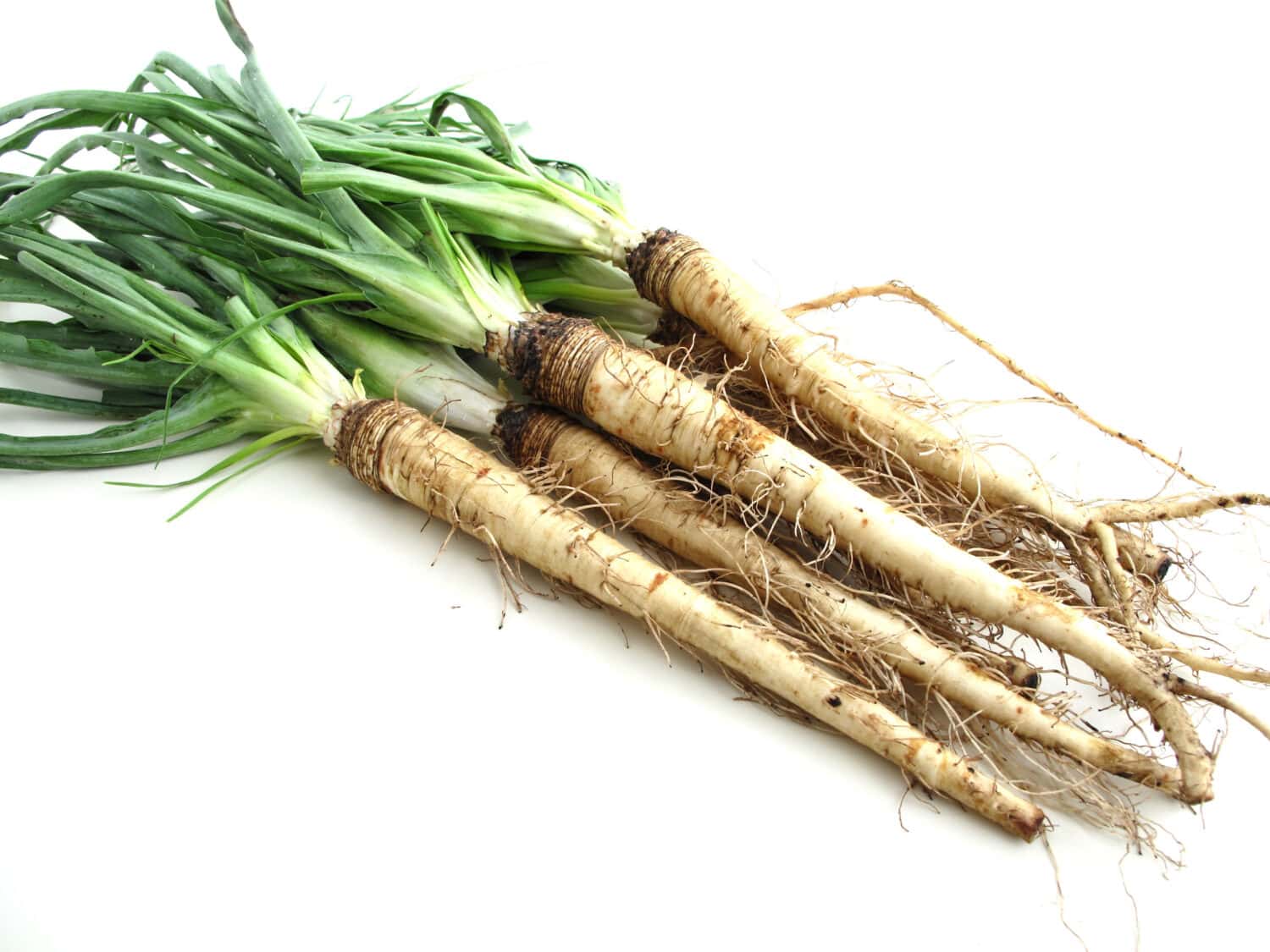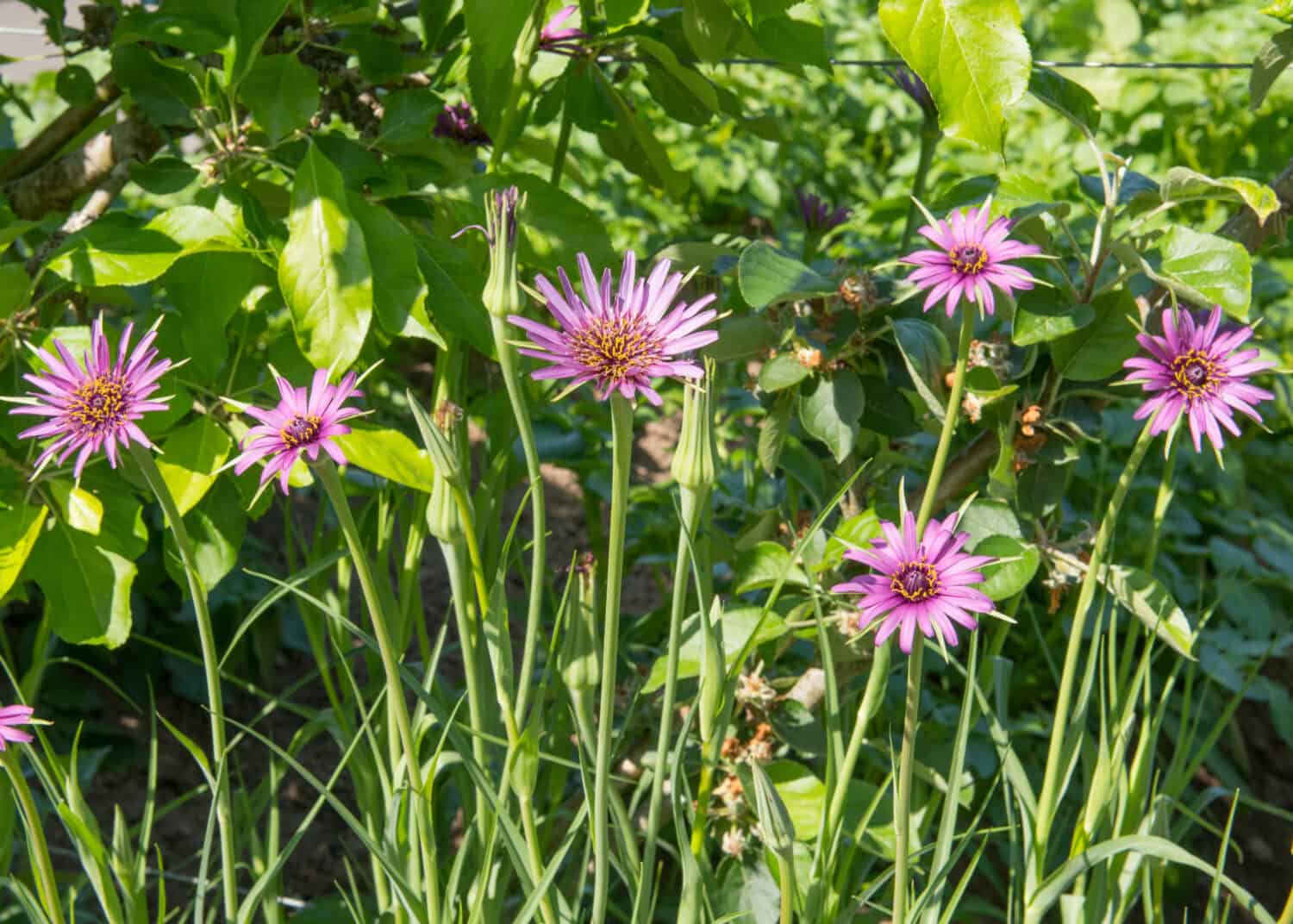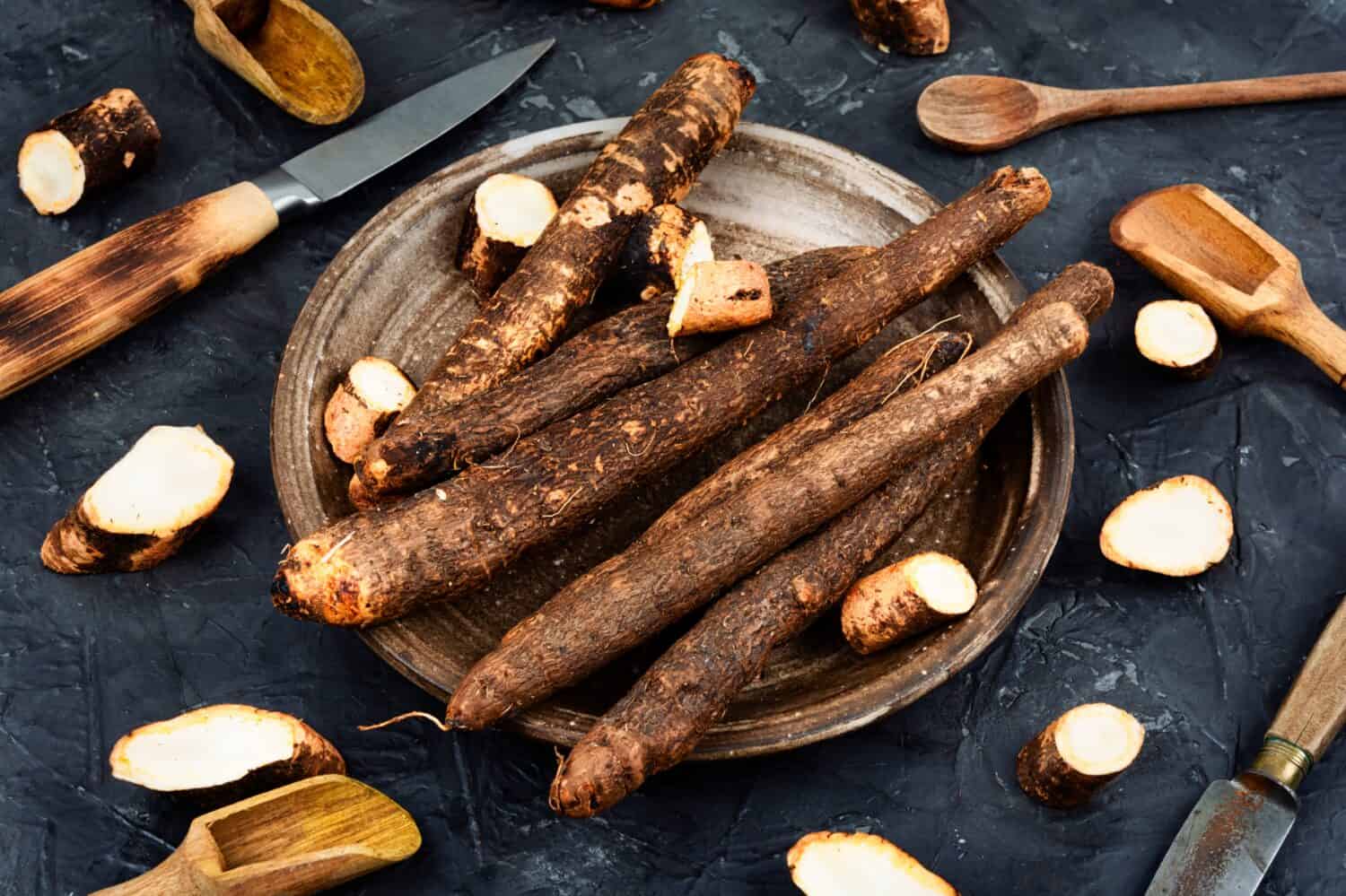Have you tried all the popular root vegetables, using the same boring recipes? Parsnips? Tried it! Carrots? Been there! What if there was a less common root vegetable that packed a powerful flavor and just as powerful healing benefits? Well, there is! Introducing salsify, a root vegetable that you didn't know you needed in your life. In this article, we will answer the question: what is salsify? We will also discuss how you cook it, its health benefits, and so much more.
What is Salsify?

©Joseph J. Erdos/Shutterstock.com
Salsify is a root vegetable that belongs to the dandelion family. Some people describe it as a cross between a parsnip and a dandelion root because its physical appearance resembles a mix of the two. When it comes to appearance, there are two main types. There are what people refer to as “true” salsify and “false” salsify. True salsify (Tragopogon porrifolius) is also called purple salsify, white salsify, or oyster plant. It has a white root and purple flowers. False salsify (Scorzonera hispanica) is also called black salsify or Spanish salsify and has a black root with yellow flowers.
While the two varieties differ in appearance, both belong to the Asteraceae family, and both are used in primarily the same way. When it comes to flavor, this vegetable has a mild and mineral-like flavor. It coins the name the oyster plant because some people suggest that the flavor of the mature root reminds them of oysters. However, when it is young, the root and stalk resemble asparagus in flavor.
Where to Find Salsify

©Peter Turner Photography/Shutterstock.com
Geography
Black salsify is most common in Belgium, France, Germany, and the Netherlands. Purple or “true” salsify is native to southeast Europe and North Africa but can also be found in North America. Another type that can be found in North America is Western salsify (Tragopogon dubius). This variety is also known as yellow salsify. Although it is also native to Eurasia, it was brought over by early settlers to North America as a food source. According to Montana State University, “It has been reported in every state except Alabama, Florida, Mississippi, and South Carolina.”
Although multiple species of salsify exist across America, and the roots of all species are edible, “true” salsify is the most commonly collected and used for consumption. It is widespread across America and can be found along roadsides. Additionally, it can be found in fields, orchards, or vineyards. You can find the common variety growing in almost every state in America.
For Purchase
If you want to purchase this vegetable, you can find seeds in local garden centers. If you want to purchase it fresh, it may be a little harder. Salsify is a hard vegetable to harvest, so it is not always readily available. However, you can use programs like Instacart to get it delivered to you. Additionally, it can be available with other online retailers and certain grocery stores or markets. You can expect to pay, on average, between $15 and $20 dollars for a pound of this vegetable.
How to Cook and Store Salisfy

©New Africa/Shutterstock.com
Salsify is a great vegetable to have in your kitchen. It is better for you than some other root vegetables. According to the Farmers Almanac, this root vegetable has actually earned the superfood status. This is due to its high levels of “iron, vitamin C, thiamin, calcium, and phosphorous.”
Black and white varieties have different flavors. Black has more of an oyster taste to it, which is why many people tend to use it in soups and chowders. White, however, more closely resembles the flavor of asparagus or artichoke hearts.
Cooking and Preparing
The first step in preparing your salsify for cooking is to wash it thoroughly. Being a root vegetable, it is often covered in dirt and soil. Wash it under cold water and scrub off any debris and dirt. People debate on whether or not to peel it before cooking. Many people argue that you should cook it before peeling it. This is because it can lose some of the flavor, and it turns brown after peeling.
Depending on your cooking method, you can rub the peel or skin of the salsify off after it is cooked. However, others prefer to peel the root before cooking to avoid any lingering dirt or debris. If you peel prior to cooking, put the peeled roots into a bowl of cold water and lemon to prevent them from turning brown. Additionally, you want to trim off the ends.
Boiling is a common cooking method for salsify. After following the steps above, you could boil your salsify and then add the butter and seasoning of your choice. However, like other root vegetables, you can also bake, sauté, roast, or braise it as well.
Cooking Guidelines
Below are general guidelines for the different methods of cooking salsify.
| Cooking Method | Guidelines |
|---|---|
| Boiling | Wash thoroughly and boil for 6-8 minutes. You can peel prior or rub the skin off after boiling. |
| Braising | When braising or using in a casserole, cook until tender. It should take about 30-45 minutes. |
| Frying | Parboil them for 5-10 minutes prior and refresh them in cold water before frying. For deep frying, fry them in wet batter until golden brown. |
| Sauté | Sauté without batter for 10-15 minutes or until the roots become tender. |
| Simmering | Simmer in a covered container. If the root is whole, simmer for 15-30 minutes. If it is in pieces, simmer for 5-15 minutes. |
| Steaming | Steaming the whole root takes 20-40 minutes. Steaming pieces of the root will take 5-10 minutes. |
Storing
Salsify is a vegetable that is best eaten fresh. If you purchase it and don’t plan on consuming it right away, then you can place it unwashed in a plastic bag and store it in the fridge. Additionally, your roots should be kept in a place with high humidity to keep them from shriveling. When you store this vegetable correctly, it should last for about a week in the fridge. Even if it does shrivel slightly, it is still safe for you to consume.
Recipes Ideas

©New Africa/Shutterstock.com
Salsify is very versatile. It is great for soups and stews, and it can even be mashed like a potato. Although the foliage of the plant is edible when the plant is young, as well as the stalk, the root is what most people focus on when cooking it for their recipes. Below are some ideas of recipes that you can make with this root vegetable.
Roasted Salsify
Salsify goes great with potatoes, celery, and onion. Try creating a roasted salsify and vegetable combination. Wash and peel your potatoes and salsify, then chop them into small pieces. Next, wash and chop your celery and onion. Add two tablespoons of butter or oil of your choice to the pan over medium-high heat. Once it is heated, add in your vegetables along with some salt, crushed peppercorns, and any additional seasoning of your choice.
Salsify Salad
Additionally, salsify goes great in salads. You can choose to roast it and add it to any leafy green salad of your choosing, but another great choice is to add it to a bulgur salad. Cook your bulgur, or you can substitute rice, farro, quinoa, or a grain of your choice. Clean, peel, and chop your salsify. Roast them in the pan with the oil and seasoning of your choice. Add garlic and a diced shallot. Once both are done, mix the salsify mixture with the bulgur and add golden raisins, basil, and pecans. Mix all together and dress to your preference.
Health Benefits
Not only is this root vegetable delicious, but it is also nutritious. Salsify is high in inulin. Inulin is a type of dietary fiber that has been linked to many health benefits. Some of those benefits include controlling diabetes, improving digestive health, and benefiting overall gut health. Another thing that salsify is rich in is iron. Iron helps promote healthy hair growth, so regularly consuming this root vegetable can help promote better hair growth.
Additionally, its mixture of potassium, calcium, and sodium allows it to help control blood pressure levels. It also has a blend of essential vitamins and minerals that help it to bolster your immune system. It is a great vegetable to have in the kitchen to keep both your tastebuds and your body happy.
Your Salsify Checklist

©Lunov Mykola/Shutterstock.com
| Category | Description |
|---|---|
| Food Type | It is a root vegetable that belongs to the dandelion family |
| Appearance | “True” salsify has a white root and purple flowers. “False” salsify is also called black salsify or Spanish salsify and has a black root with yellow flowers. |
| Where to Find Salsify | Black salsify is most common in Belgium, France, Germany, and the Netherlands. Purple or “true” salsify is native to southeast Europe and North Africa but can also be found in North America |
| How to Cook Salsify | Boiling is a common choice. However, you can also bake, saute, roast, or braise it as well. |
| How to Keep Salsify | It is best eaten fresh. If you don’t plan on consuming it right away, then you can place it unwashed in a plastic bag and store it in the fridge for a week. |
| Health Benefits | High in inulin and Vitamin C. It benefits immune function digestive health, and can promote healthy hair growth. |
Frequently Asked Questions
Can you eat salsify raw?
While the young roots can be eaten raw if sliced thinly enough, most people choose to cook their salsify before consuming. You can put raw salsify on a salad, but it is more common to boil, steam, or bake the roots.
What does salsify taste like?
Black salsify has more of an oyster taste to it, which is why many people tend to use it in soups and chowders. White salsify, however, more closely resembles the flavor of asparagus or artichoke hearts.
Does salsify need to be peeled?
People debate on whether or not to peel your salsify before cooking. Many people argue that you should cook your salsify before peeling it. This is because it can lose some of the flavor, and it turns brown after peeling. However, other people like to peel it first to ensure that they get rid of as much soil and dirt as possible. It is up to personal preference and what makes sense for the recipe. For example, if you are boiling it, leaving the skin on makes little difference. However, if you sauté it in a pan with other vegetables, you may want to peel it before cooking.
What can I use as a substitute for salsify?
If you are having trouble finding this vegetable or simply do not enjoy it, you can substitute it with an artichoke heart, asparagus, carrot, parsnips, or turnips.
Up Next:
- What is Chayote Squash? How to Cook, Health Benefits, Recipes & More
- What is Samphire? How to Cook, Taste, Health Benefits & Recipes
The image featured at the top of this post is ©New Africa/Shutterstock.com.